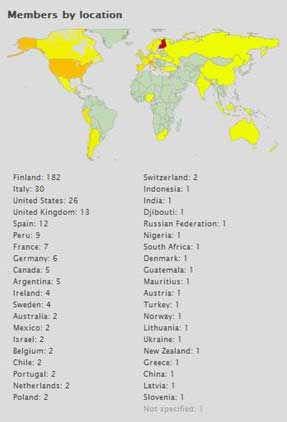By this point we’ve all heard about crowdsourcing. It's a way to outsource a project and let a large group of people create it online. (See video at the end of the post for a fuller explanation, complete with animated fish.) We’ve heard about crowdsourcing logo designs, requests for proposals (RFP's) or even determining which paintings to show in an exhibition. But how about an full-length opera? Well, one company is crazy enough to try it.
The Savonlinna Festival in Finland has been developing an opera through the collaboration platform wreckamovie since 2010. The Opera by You initiative has been developed in five phases, some of which overlap. First, the crowd collaborated on a plot and name for the opera in July 2010. They decided on the title Free Will and the following plot, as described by Paivi Salmi, Project Manager of Opera by You:
God has had enough of all the misery that people are suffering from and calls a meeting with the angels. They decide to send a few dead geniuses back to Earth to make things better. They are supposed to make a huge difference in science and art and create world peace. The geniuses are Joan of Arc, Oscar Wilde and Wolfgang Amadeus Mozart.
Second, writers began work on the libretto (or script) to the opera. The process is halfway completed and is set to be done in May. Third, the composers in the group began setting the words to music in September. Fourth, the project coordinators launched the visualization plan. Salmi described the process.
Visualization means to us creating the concept of “environment” on the stage: the era of the opera, stage sets, wardrobe, lightning etc. We have decided together with the community that the story of Free Will will take place in our modern time and now we proceed on deciding how the different scenes look like visually.

- Visualizations of Hell in the year 2012 from Opera by You
The libretto, composing and visualization plans are set to be ready at the end of May 2011. In the last phase, the whole concept will be moved to the hands of the Savonlinna Opera Festival for production, and that is where the crowdsourcing will end when it comes to the live opera production. The opera will be produced during Savonlinna’s 2012 summer festival season. The crowdsourcing will continue in that the existing community within the wreckamovie platform will work with the current plot, creating an animated movie version of the live opera. To see the opera creation in action, visit http://operabyyou.wreckamovie.com.
Paivi Salmi manages the web community creation process as well as the marketing and community partnership initiatives. I caught up with Salmi and asked her about the collaborative process of crowdsourcing the opera.
How did this idea originally come about? The Savonlinna Opera Festival has been frontrunner in developing opera genre in Finland. We have had several projects for instance for creating operas for kids. This spring we will again launch this kind of project where kids create opera as part of their normal school work. The Savonlinna Opera Festival has had several Finnish world premieres with quite unusual productions. We are actively searching new ways of reaching new audiences for the opera and also new ways of creating the opera. So in the spirit of “Web 2.0,” we decided to try the collaborative product development or crowdsourcing in the web also in the field of the opera.
How did you choose wreckamovie as the platform to create the opera? The wreckamovie platform provides the basic tools for collaborative discussion and working. It is also well-known in the Europe at least and already has lots of members interested in collaborative working on the web. We also plan to create an animated movie about the plot of our opera and for that second phase of the project, wreckamovie will the best available tool.
With so many people collaborating on one project, how do you select the best ideas? How do you deal with differing opinions on the direction the project should take? We have five operatives in the team who are experienced opera creation professionals (a script writer, a stage director, a composer, a production specialist and a visualization expert) who will guide the creative process in the web. Their task is to select best ideas, give the "developing” tasks for the community.

- Opera by You Community Members by Country.
Who are the people collaborating on the project? Do you know the make-up as far as country, age, and profession? Do most have an artistic background and collaborate on areas of the project they specialize in? When it comes to age, they are average 35 years old, mostly motivated by composing and visualizing. We don't collect any information about their profession or education, so we do not know if they already are professionals in the field of opera or classical music.
How do you plan to distribute the opera once it is produced at the festival in 2012? Will the footage be available online, recorded or streaming? The opera will be performed 3 times during summer 2012 in the Savonlinna Opera Festival. If some opera house is interested in the project, we will naturally export the production. We plan to make footage available and also animated movie which will be distributed online. The project was launched at the Opera America annual meeting in L.A. last June.
How are you addressing intellectual property issues for the contributors to the project? Every member has to sign user agreement and accept Wreckamovies terms of use where the member gives all rights to the project. So there will be no intellectual property issues.
What has been the response from the online community and the opera community at large? The community has been growing steadily, but only certain members are active in all "production lines". It goes so that some are writers, some others composers and some only interested in the visualization part. But mainly people are very excited and willing to work "for free". We also want make it easy to just anyone without any classical music or opera experience to participate to the collaborative work. We have reached a very good visibility to our project in the internet. For instance in the launch phase of the project there were lots of articles in online media for instance in Latin America, India and Europe. The larger opera community has been very interested and curious. We have been asked to present the project in several conferences and seminars. People are also very interested in the process itself--how has it been ”structured” etc. within opera community but also in the larger community of art, theatre and even social media.
Here's a more detailed answer to the question "What is crowdsourcing?"






